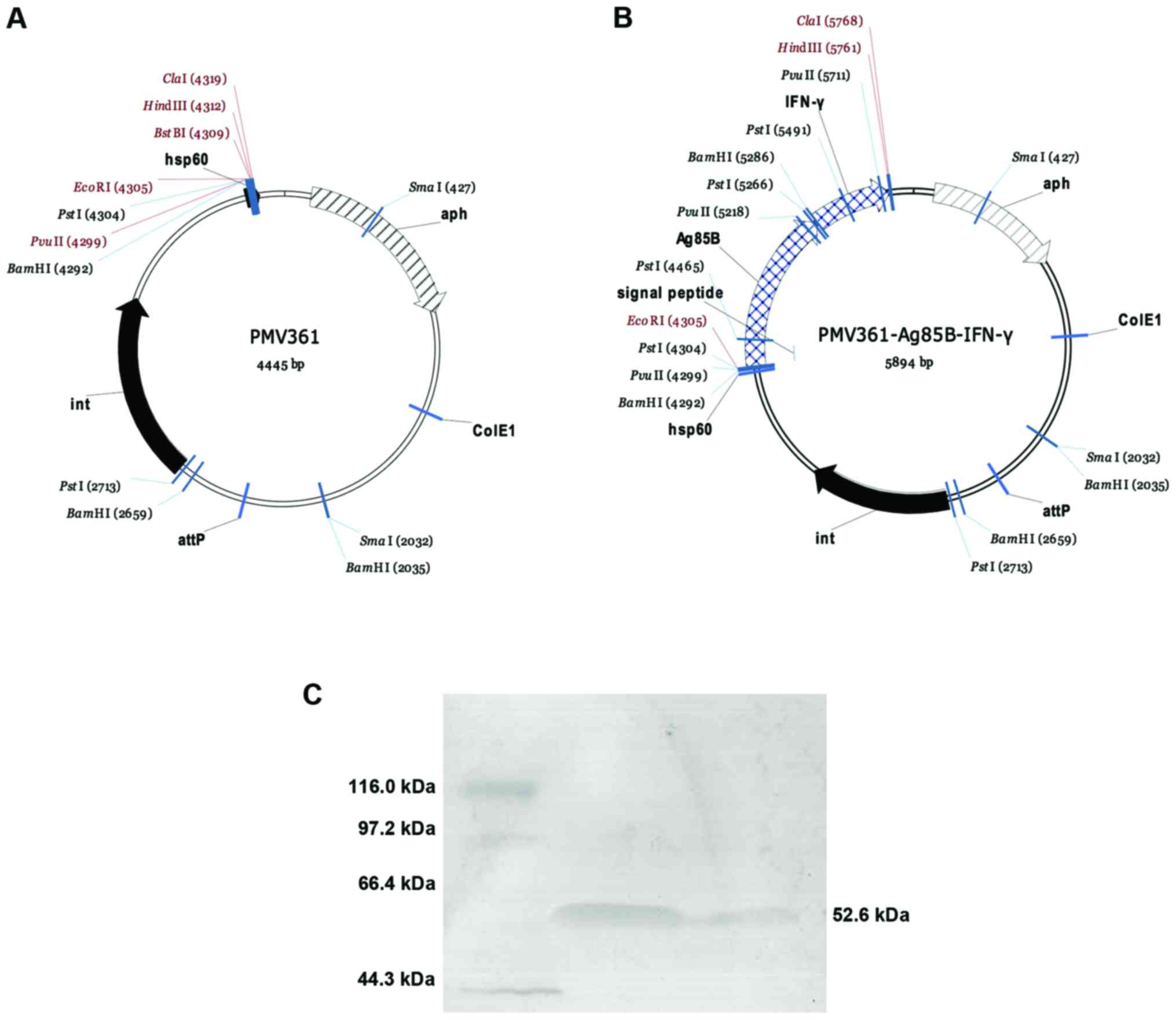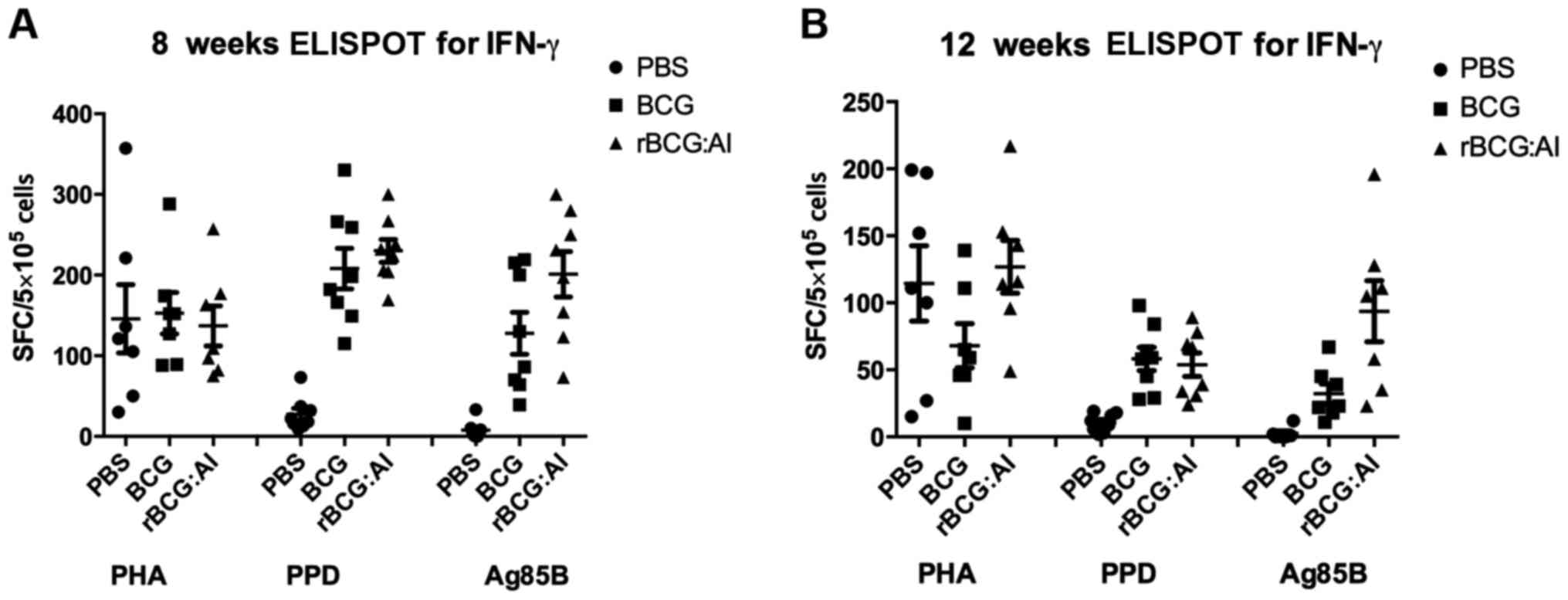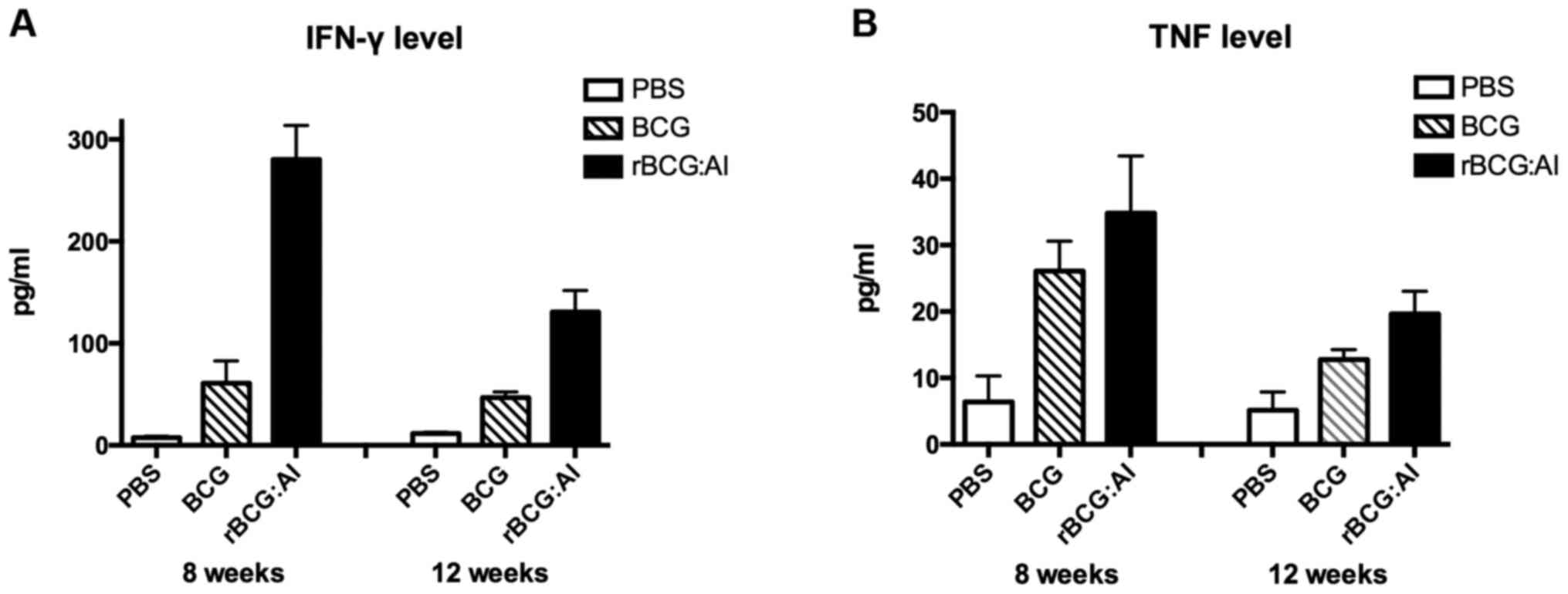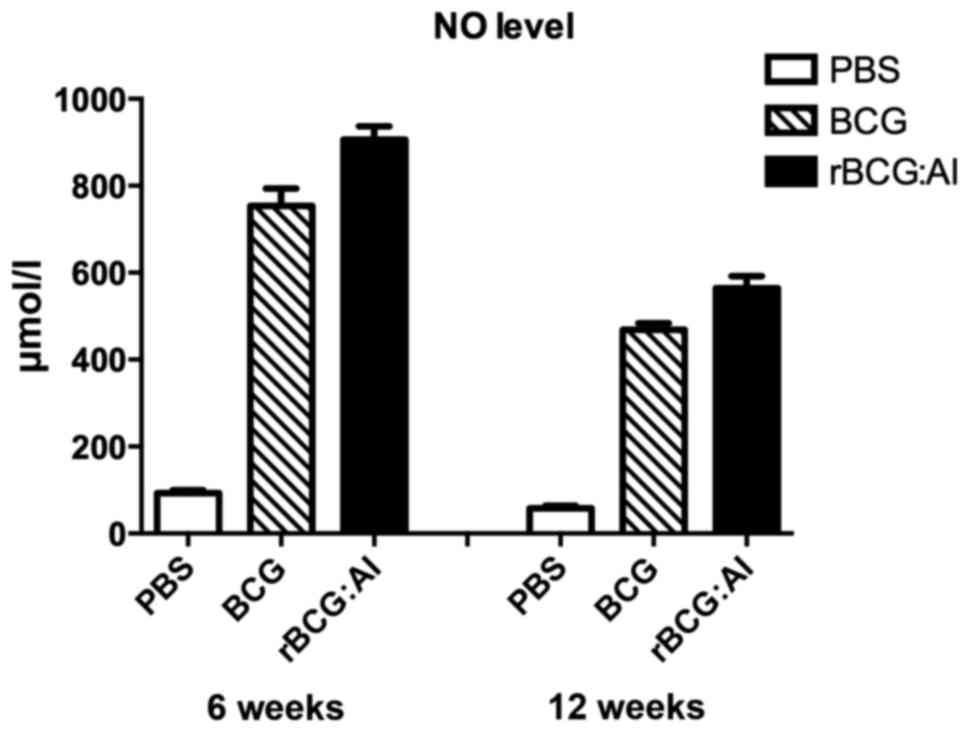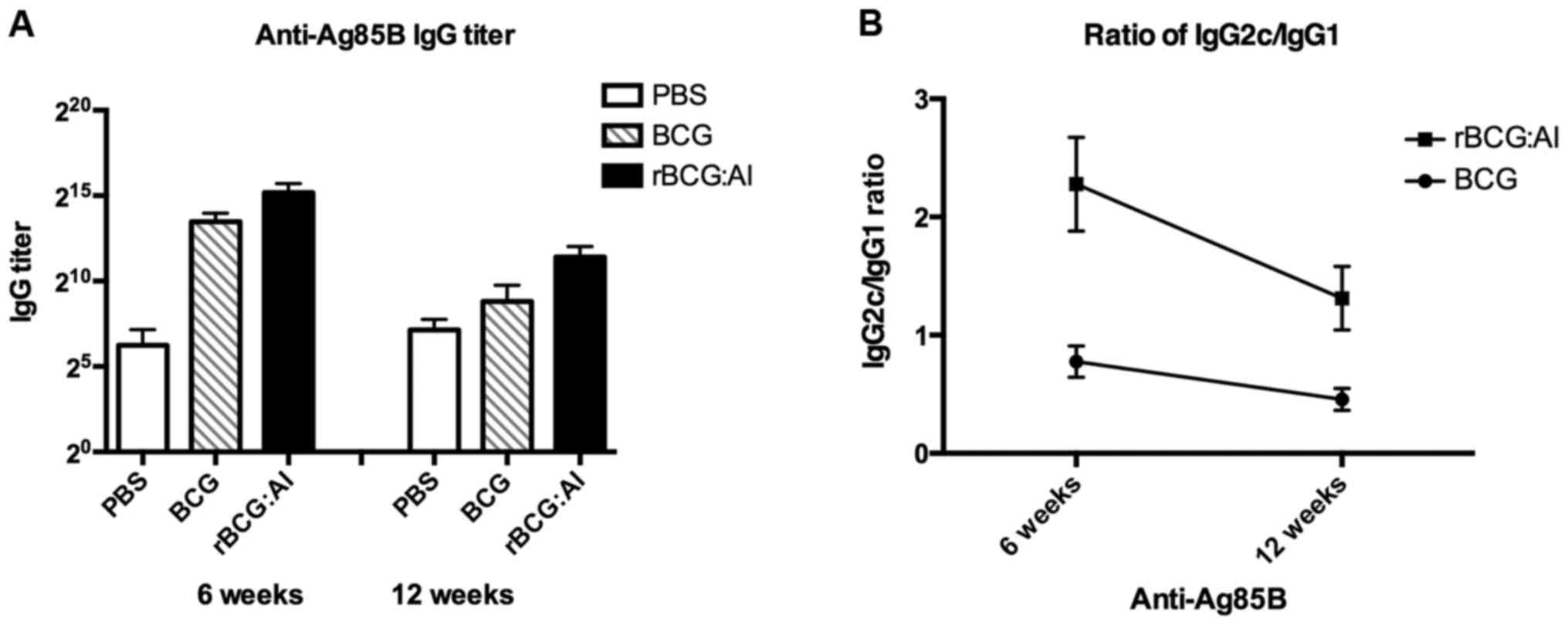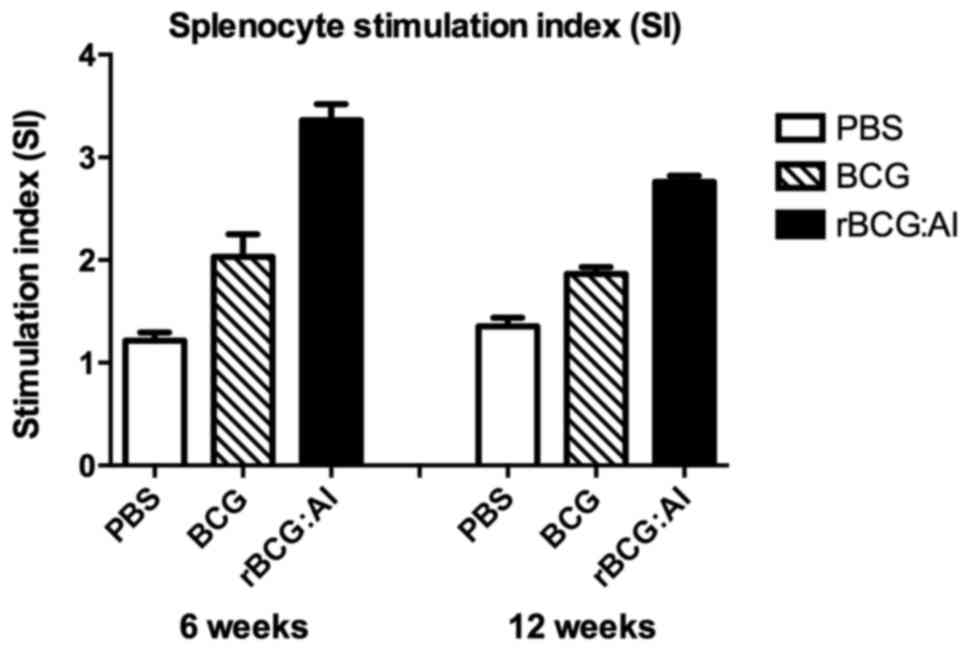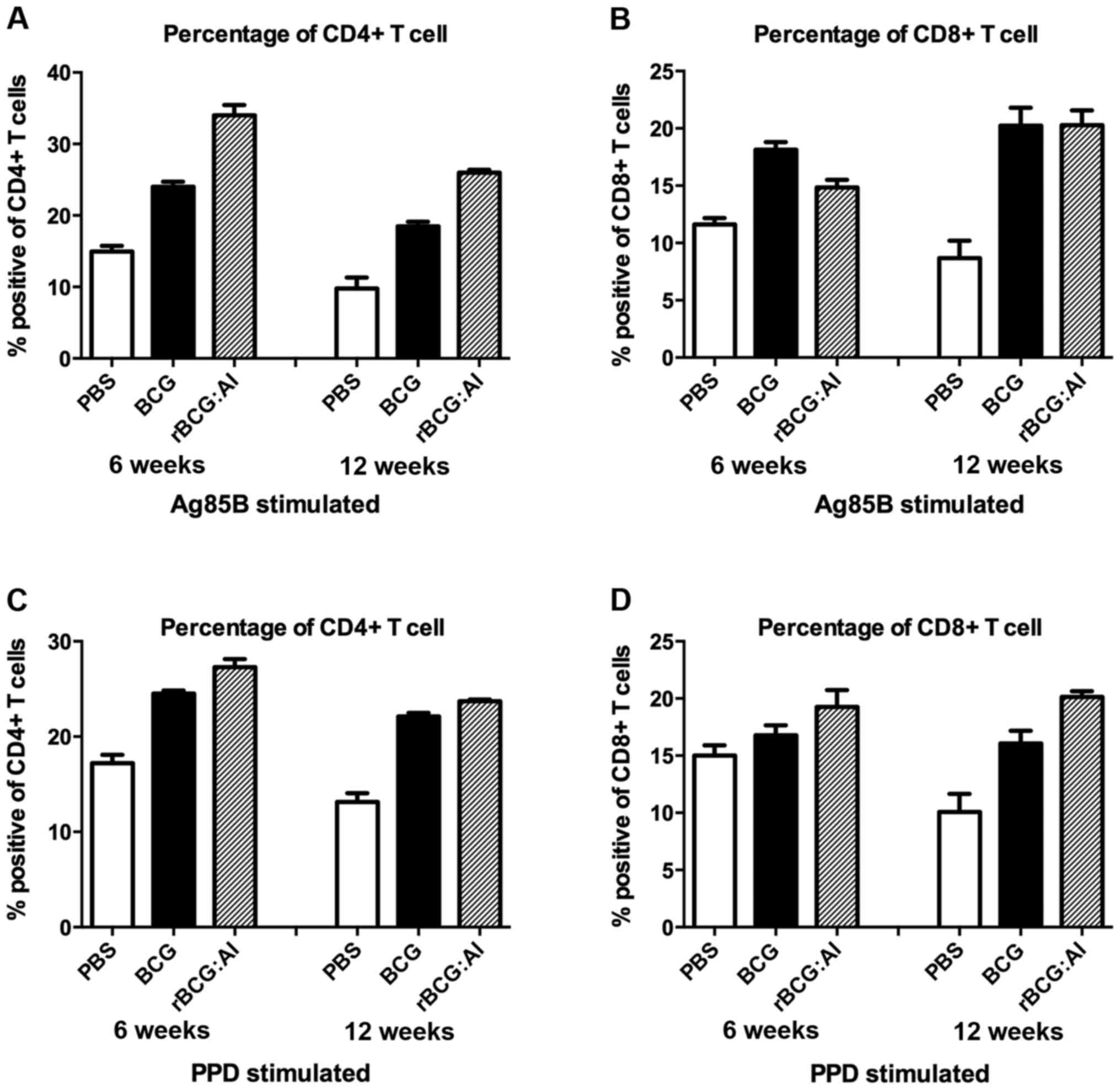Recombinant Bacille Calmette-Guérin coexpressing Ag85B-IFN-γ enhances the cell-mediated immunity in C57BL/6 mice
- Authors:
- Published online on: March 28, 2017 https://doi.org/10.3892/etm.2017.4273
- Pages: 2339-2347
-
Copyright: © Liu et al. This is an open access article distributed under the terms of Creative Commons Attribution License.
Abstract
Introduction
Tuberculosis (TB) is one of the leading infectious diseases worldwide. The latest surveillance data by the World Health Organization (WHO) reveals that in 2006, there were 9.2 million new cases and 1.7 million deaths from TB (1). The TB pandemic has continued despite widespread use of the only available licensed TB vaccine Bacille Calmette-Guérin (BCG) under the WHO expanded program on immunization and despite the use of directly observed chemotherapy programs for those diagnosed with active disease. Although BCG seems to provide protection against disseminated disease in newborns and children, its efficacy against pulmonary TB is poor especially in adults, which highlights the need for a better vaccine regimen (2).
During the past decades, progress has been made in explanation of BCG failure. The main potential vaccination strategies against TB included recombinant BCG (rBCG), attenuated strains of Mycobacterium tuberculosis (M. tb), subunit vaccine approaches and live, and non-replicating viral vector-based delivery systems. The most important strategy is to stimulate more potent immune responses against M. tb. In production of rBCG, three strategies have been mainly used. The first is based on the restoration of deleted BCG genes (deleted in the process of M. bovis attenuation) that encode immunogenic antigens. Another approach is based on rBCG that produces large amounts of strong immunogenic protective antigens, and the third is to construct rBCG that secrete cytokines relevant in anti-TB immune response such as interleukin (IL)-2, interferon (IFN)-γ, or IL-18 (3–5). These cytokines have been shown to activate macrophages and kill or control the growth of the M. tb. Although imperfect, INF-γ remains the best available correlate of protective immunity (6,7). Vaccines which failed to induce sufficient levels of IFN-γ are unable to protect effectively against tuberculosis in animal models (8).
Antigen 85B (Ag85B) is a secretory and immunogenic protein of M. tb and BCG with mycolyl-transferase activity, which is required for mycobacterial cell wall synthesis (9), and a study has observed rBCG30 overexpressing Ag85B resulted in better protection as compared to its parental BCG strain (10,11). Moreover, there was no significant safety issues in a phase I clinical trial of rBCG30 in more than 30 healthy adult volunteers (12,13). In the present study, the ag85b and ifn-γ genes were inserted into Mycobacterial-E. coli shuttle vector pMV361 in order to form novel rBCG viz rBCG::Ag85B-IFN-γ and its efficacy was tested in C57BL/6 mice. The Ag85B-IFN-γ fusion protein was expressed under control of the Mycobacterial heat shock protein 60 (hsp60) promoter and the ag85b signal sequence was utilized to secret it into the supernatant of the culture continuously. Expression of the fusion protein was readily detectable and IFN-γ bioactivity maintained unaffected.
Compared with BCG, rBCG::Ag85B-IFN-γ was substantially more active in inducing the production of IFN-γ and tumor necrosis factor (TNF)-α from mouse splenocytes by ELISPOT and enzyme-linked immunosorbent assay (ELISA). ELISA analysis for Ag85B special IgG, IgG1, and IgG2c displayed that rBCG::Ag85B-IFN-γ can induce high level antibody titer and facilitate Th1 type immune response. Also, rBCG::Ag85B-IFN-γ improved nitric oxide (NO) production level and enhanced antigen-specific splenocyte proliferation.
Expression of various surface molecules on activated macrophages is required for optimal development of protective T cell response in tuberculosis. We characterized the expression of surface markers in human monocytes such as THP-1 cell line infection with rBCG::Ag85B-IFN-γ. It increased expression of CD80, CD86 and CD40 significantly compared with BCG.
Flow cytometry analysis showed that rBCG::Ag85B-IFN-γ activated CD4+ T cells remarkably and improved CD8+ T cells gradually with time. Although IFN-γ is clearly necessary, using it as a single immune parameter may not always sufficient to bring protection (14). Multifunctional T cells secreting IFN-γ, TNF-α, and IL-2 have been shown to correlate with protection in Leishmania major infection in mice (15). We assess all combinations of IFN-γ, TNF-α and IL-2 at the single-cell level by intracellular cytokine staining and parameter flow cytometry analysis.
The immunostimulatory properties of rBCG::Ag85B-IFN-γ increased cell mediated immune response compared to the parent BCG strain. Considering the action of IFN-γ in clearing the infection pathogen, rBCG::Ag85B-IFN-γ may be a potential candidate vaccine and a superior agent for immunotherapeutic protocols in the future.
Materials and methods
Bacterial strains and cultures
M. bovis BCG (obtained from Shanghai Institute of Biological Products Co., Ltd., Shanghai, China), M. tb H37Rv and rBCG::Ag85B-IFN-γ (constructed as below) were grown in Middlebrook 7H9 medium (BD Biosciences, Sparkers, MD, USA) supplemented with 0.5% glycerol, 0.05% Tween-80 and 10% ADC (BD Biosciences) or on solid Middlebrook 7H10 Agar medium (BD Biosciences) supplemented with 0.5% glycerol and 10% ADC. When required, the antibiotic kanamycin was added at a concentration of 25 µg/ml. E. coli DH5-α was grown in Luria-Bertani medium (Oxoid Ltd., Basingstoke, Hampshire, UK) and used for cloning and extracting plasmid.
Construction of a rBCG expression Ag85B and IFN-γ
Coding sequences for ag85b (containing signal sequence) and mouse ifn-γ were amplified from the M. tb H37Rv genomic DNA and mouse spleen tissue cDNA respectively by PCR using the primers shown in Table I. The ag85B and murine ifn-γ coding regions were cloned into the Mycobacterial-E. coli shuttle vector pMV361, in which gene expression is under the control of the strong M. bovis hsp60 promoter. Inserted genes were sequencing confirmed and the rBCG substrain was produced by electroporation transfecting BCG-Danish strain cells with the recombinant plasmid pMV361-Ag85B-INF-γ. The transformed BCG was plated on 7H10 solid medium supplemented with 25 µg/ml kanamycin and grown at 37°C for 3 weeks. The resulting recombinant clones containing pMV361-Ag85B-INF-γ were designated rBCG::Ag85B-IFN-γ.
Western blotting detection of expressed Ag85B and INF-γ
Expression of the recombinant fusion protein by rBCG::Ag85B-INF-γ was determined by western blotting. The individual rBCG clone was selected and grown in Sauton medium (0.25 g MgSO4·7H2O, 0.25 g K2HPO4, 1.0 g citric acid, 4.0 g sodium glutamate, 30 ml glycerol, 5 mg ZnSO4 and 25 mg ferrum-ammonium citrate in 500 ml ddH2O) containing 25 µg/ml kanamycin. After 2 weeks of growth, protein expression was induced by heating at 45°C for 60 min. The bacterial cultures were centrifuged at 8,000 × g for 20 min. The culture supernatants were concentrated as previously described (16) for western blot detection. A total of 25 µl of the concentrated culture filtrates from rBCG::Ag85B-IFN-γ were analyzed for expression of the recombinant fusion protein by western blotting using anti-Ag85B rabbit polyclonal sera.
Determination of IFN-γ levels and bioactivity in the bacterial culture supernatants
The ability of the bacilli to secrete murine recombinant IFN-γ was verified by measuring the concentration of the cytokine by ELISA in the bacterial culture supernatants (17). The mouse INF-γ Quantikine ELISA kit (R&D Systems, Inc., Minneapolis, MN, USA) was used to determine the IFN-γ activity of rBCG::Ag85B-IFN-γ following the manufacturer's instructions. The bioactivity of IFN-γ produced by the rBCG::Ag85B-IFN-γ strain was calculated according to the standard curve. The experiment was performed twice.
Animal vaccination
Five-week-old female C57BL/6 mice (Slaccas Laboratory Inc., Shanghai, China) were used in the ABSL-2 animal facility at Second Military Medical University (Shanghai, China). Mice received free access to food and water throughout this study. All experiments were performed in accordance with the local Ethics Committee guidelines. C57BL/6 mice (12 per group) were immunized subcutaneously at the dosage 5×106 CFU of BCG or rBCG in 200 µl phosphate-buffered saline (PBS). Mice were sacrificed to analyze the immune responses at 6 and 12 weeks after the immunization. As an additional control, mice of the other group were injected with PBS only. The experiment was repeated twice.
ELISPOT assay for IFN-γ from splenocyte cultures
At 6 and 12 weeks after the vaccination, mice were sacrificed, and their spleens removed aseptically into RPMI-1640 medium containing 10% fetal calf serum (FCS), 2 mM glutamine, 50 µM β-mercaptoethanol, 100 µg/ml streptomycin and 100 U/ml penicillin. Spleens were gently ground through a 70 µm cell strainer, and the single-cell suspensions were prepared with Lympholyte-M (Cedarlane Laboratories, Burlington, NC, USA) by density-gradient centrifugation procedure. We used the mouse IFN-γ ELISPOT kit (U-CyTech Biosciences, Utrecht, The Netherlands). Analyses were conducted on the splenocytes from five mice each group. Diluted cells were added to the wells of the ELISPOT plate at 5×105 cells per well in culture medium as described above containing purified protein derivatives (PPD, 5 µg/ml), Ag85B (5 µg/ml) or phytohemagglutinin (2 µg/ml, as positive control) as stimulus. The plates were incubated at 37°C, 5% CO2, 100% humidity for 36 h and the IFN-γ secreting T cells were evaluated. Spots were counted by use of an immunospot image analyzer. Wells with <5 spots were not used for calculations.
ELISA analysis for IFN-γ, TNF-α and IL-4
Single cell suspensions were acquired and diluted in 2 ml culture medium containing the same concentration of stimulus as described above to the 12-well plates at 1×106 cells per well. The plates were incubated at 37°C, 5% CO2, 100% humidity for 36 h. The suspensions were collected of the splenocyte cultures for sandwich ELISA to detect the level of the cytokines. The cell deposits were harvested to prepare for flow cytometry analysis. We used the mouse IFN-γ ELISA kit, TNF-α ELISA kit and IL-4 ELISA kit (eBioscience, Inc., San Diego, CA, USA). The concentration of the cytokines was calculated in the suspension according to the standards curve.
NO production determination
This procedure for NO determination was based on the Griess reaction. Culture supernatants were acquired as described above. A total of 100 µl of the splenocyte culture supernatants or sodium nitrite standard 100 µl were mixed with an equal volume of Griess reagent (Sigma-Aldrich, St. Louis, MO, USA). In addition anaerobic conditions were achieved by purging the reaction mixture with high purity argon gas for ≥5 min. After 5 min at room temperature, the absorbance at 550 nm (A550) was measured. The NO concentration was calculated in the culture supernatants according to the sodium nitrite standard.
ELISA analysis for IgG, IgG1, and IgG2c
Sera were collected from the immunized mice to monitor the antibody response by ELISA. Corning Costar 9018 ELISA plates (Corning Costar, Inc., Corning, NY, USA) were coated with Ag85B (5 µg/ml) overnight at 4°C. The plates were blocked with PBS containing 1% bovine serum albumin (BSA; Bovogen Biologicals Pty Ltd., East Keilor, VIC, Australia). Sera were added at serial 2-fold dilution (beginning at a 1/50 dilution). After washing, and addition of horseradish peroxidase conjugated goat anti-mouse IgG, IgG1 and IgG2c (SouthernBiotech, Birmingham, AL, USA) diluted at 1/5,000, 1/1,000 and 1/1,000, respectively in blocking buffer (PBS containing 1% BSA) for 1 h, the plates displayed the staining by o-phenylenediamine substrate. Antibody titers were expressed as reciprocal end point titers. The mean antibody titers were the antilog of the average logarithm for antibody titer of 5 mice.
Antigen-specific splenocyte proliferation
Spleens of the immunized mice were removed aseptically to acquire the lymphocytes as described above. The isolated lymphocytes were washed in medium twice and cultured in RPMI-1640 + 10% FCS containing 100 µg/ml streptomycin and 100 U/ml penicillin. Cells were adjusted to 1×105 cells/ml and 0.1 ml was plated with either 20 µl PBS or 20 µl Ag85B (300 µg/ml) in 96-well plates. Cells were cultured for 2 days in 5% CO2, 100% humidity and 37°C for MTS assay (CellTiter 96® Aqueous Non-Radioactive Cell Proliferation Assay kit; Promega Corp., Madison, WI, USA). The proliferation was assessed with splenocyte stimulation index (SI) (18).
Flow cytometry analysis for CD4+ and CD8+ subsets
The spleen tissue and single cell suspensions were prepared as described above in cell staining buffer (BioLegend, Inc., San Diego, CA, USA). The debris was removed by filtration of the cell suspension through 70 µm nylon mesh strainer. Viable cells were counted and suspended in cell staining buffer at 1×107 cells/ml. Cell suspension (100 µl) was distributed into aseptic Eppendorf plastic tubes. Cells were blocked with PBS containing 1% BSA. Isotype controls of fluorescein isothiocyanate (FITC) and phycoerythrin (PE) conjugated anti-mouse IgG2b were used. FITC 0.25 µg anti-mouse CD4 and 0.25 µg PE anti-mouse CD8 (eBioscience, Inc.) per million cells in a 100 µl total staining volume were added, then incubated in the dark at 4°C for 20 min. Cells were washed twice and the cell pellets were resuspend in 0.5 ml cell staining buffer for analyzes by flow cytometry (FACSCalibur; BD Biosciences). A total of 10,000 events per test were collected.
THP-1 cell culture and rBCG::Ag85B-IFN-γ treatment
THP-1 cells were cultured in complete medium RPMI-1640 supplemented with 10% FBS. The cells were seeded in complete medium containing Phorbol-12-myristate 13-acetate (20 ng/ml) in 12-well plates at 1×106 cells/well for 18 h and induced to macrophages. Then the monocyte derived macrophage were treated with PBS (control group), BCG (1×107 CFU) or rBCG::Ag85B-IFN-γ (1×107 CFU) for 36 h. Supernatants were collected for cytokine assays, and cells were collected for surface marker flow cytometry analysis.
Cells surface marker flow cytometry analysis
For flow cyto-metry analysis, cells were collected, washed and resuspended in PBS supplemented with 1% FBS, thereafter cells were stained with fluorochrome-conjugated mAb. We divided samples into two parts at 1×106 cells/tube. One was stained with FITC-conjugate anti-human CD40 and PE conjugate HLA-DR and the other was stained with FITC conjugate CD86 and PE conjugate CD80 (Caltag Laboratories; Invitrogen Life Technologies, Carlsbad, CA, USA). Cells were incubated in the dark at 4°C for 20 min. Following two washes, cell pellets were resuspend in 0.5 ml cell staining buffer for analyses by flow cytometry. A total of 10,000 events per test were collected. Data were analyzed using CellQuest software (version 7.5.3.; BD Biosciences) or FACS Express 3 software (DeNovo Software, Ontario, ON, Canada).
Intracellar cytokine staining analysis
The peripheral blood from the vaccinated mice were used to acquire peripheral blood mononuclear cell (PBMC) single-cell suspensions using Histopaque-1077 kit (Sigma-Aldrich) based on density centrifugation. The cells were diluted in 2 ml culture medium containing the same concentration of stimulus as described above to the 12-well plate at 1×106 cells per well. The plate was incubated at 37°C, 5% CO2, 100% humidity for 36 h. Brefeldin A solution (eBioscience, Inc.) of 1 µl was added into the cell culture for 4 h to inhibit the cytokine transport. Cells were harvested and 100 µl of Reagent A was added (fixation medium, fix and perm cell permeablization reagent; Caltag Laboratories; Invitrogen Life Technologies) and incubated for 15 min at room temperature. Cells were washed, and the cell pellets resuspended, then adding 100 µl of Reagent B (permeabilization medium) and the 1 µl FITC conjugate anti-mouse IL-2, 1.25 µl PE conjugate IFN-γ and 20 µl PerCP-Cy5.5 conjugate TNF-α (eBioscience, Inc.) per million cells. Vortexed and incubated for 20 min in the dark at 4°C. Cells were wash and the cell pellets resuspend in 0.5 ml of cell staining buffer for analyzes by flow cytometry.
Data analysis
Statistical significance was determined using one-way ANOVA with Kruskal-Wallis tests, Tukey and Dunnett tests of GraphPad Prism 5.0 for Windows (GraphPad Software, Inc., San Diego, USA). PBS group was regard as negative control. All the other groups were compared with BCG group. P<0.05 was considered to indicate a statistically significant difference.
Results
Construction of rBCG secreting Ag85B and IFN-γ
Novel rBCG capable of expressing Ag85B and IFN-γ, on a shuttle vector pMV361 is shown in (Fig. 1A). Further, rBCG::Ag85B-IFN-γ expressed and secreted a relatively high level of fusion protein as shown in Fig. 1B. The bioactivity of IFN-γ produced by the rBCG::Ag85B-IFN-γ strain was 21.85±7.06 pg/ml (equal to 2.2×106 U/mg).
Cytokine response
Cell-mediated immune responses were evaluated by IFN-γ ELISPOT assay and sandwich ELISA analysis for IFN-γ, TNF-α and IL-4. The amount of IFN-γ secreted is shown in Fig. 2. It was noted that in response to purified Ag85B, IFN-γ secretion at 6 weeks was higher than that at 12 weeks. The IFN-γ level of rBCG::Ag85B-IFN-γ was 1.6- and 3-fold that of BCG at 6 and 12 weeks, respectively.
Moreover, the amount of IFN-γ secreted exhibited a decline at 12 weeks in all the groups. The effect of rBCG::Ag85B-IFN-γ on the Th1 or Th2 immune response is shown in Fig. 3. Mice immunized with rBCG::Ag85B-IFN-γ showed a significant increase in release of IFN-γ in response to stimulation with Ag85B compared with BCG at 6 and 12 weeks. Mice immunized with rBCG::Ag85B-IFN-γ showed no difference in releasing TNF-α in response to Ag85B compared with BCG at 6 weeks, but at 12 weeks they showed significantly higher level than those immunized with BCG.
NO production levels
The NO levels of the culture supernatant of the mice vaccinated with rBCG::Ag85B-IFN-γ or BCG (>450 µmol/l) showed higher levels than the mice vaccinated with PBS (<100 µmol/l) at 6 and 12 weeks. The NO level of the rBCG::Ag85B-IFN-γ group was significant higher than BCG group at 6 and 12 weeks (Fig. 4).
Humoral immune responses
Fig. 5A and B illustrate the levels of antibody response in the sera of mice against purified Ag85B. Compared with the PBS control group, mice vaccinated either with BCG or rBCG::Ag85B-IFN-γ strains induced higher levels of antibody against Ag85B. However, the mean IgG titers were as high as 1:33,900 and 1:2,460 in mice immunized with rBCG::Ag85B-IFN-γ at 6 and 12 weeks, which were significant higher than those immunized with BCG (1:10,600 and 1:300, p<0.01). The antibody titers of the PBS control group were only ~1:50.
Fig. 5C illustrates the antibody levels of IgG1 and IgG2c isotype against Ag85B. The ratios of IgG2c/IgG1 were calculated to determine the induction of Th1 or Th2 responses in animals (19). As a result in response to Ag85B, the ratio of mice immunized with rBCG::Ag85B-IFN-γ was much higher than that of BCG at 6 weeks and the ratio was higher than BCG at 12 weeks also. The results collectively revealed that the capability of the induction of Th1 protection immune response of rBCG::Ag85B-IFN-γ was higher than BCG in the experiments.
Antigen-specific splenocyte proliferation
The antigen-specific proliferation of the splenocytes isolated from the mice immunized with rBCG::Ag85B-IFN-γ was significantly higher than that of BCG or PBS as determined by SI also at 6 or 12 weeks (Fig. 6).
CD4+ and CD8+ T cell subset analysis
After vaccination with different vaccines, the lymphocyte subsets were examined for differences in their percentages by flow cytometry. As shown in Fig. 7, the levels of the CD4+ and CD8+ T cell populations were significantly higher in the rBCG::Ag85B-IFN-γ or BCG group than that in the PBS group. The percentage of CD4+ T cells of rBCG::Ag85B-IFN-γ was significant higher than that of BCG at 6 and 12 weeks whether stimulated with Ag85B or PPD.
The percentage of CD8+ T cells of rBCG::Ag85B-IFN-γ was significant lower than that of BCG at 6 weeks when stimulated with Ag85B, but at 12 weeks, they showed no difference. The percentage of CD8+ T cells in the mice vaccinated with rBCG::Ag85B-IFN-γ showed no difference with BCG at 6 weeks when stimulated with PPD, but at 12 weeks they were higher than that of BCG. Moreover, the CD4+/CD8+ ratio in mice immunized with rBCG::Ag85B-IFN-γ was significant higher than that of BCG. Therefore, the rBCG::Ag85B-IFN-γ enhanced CD4+ T cells were significantly higher and hence showed increased CD4+/CD8+ ratio.
Cells surface marker expression level
rBCG::Ag85B-IFN-γ enhanced expression of CD80, CD86, CD40 and HLA-DR. Changes in expression were found to be more significant for CD80, CD86 and CD40. The cells infected by rBCG::Ag85B-IFN-γ produced a 12–38% increase in the percentage of positive cells of these markers compared to infected with BCG and demonstrated small increases in expression of HLA-DR. ALs especially showed a trend of increasing CD80 expression when compared with BCG.
Multifunctional T cell analysis
Using multiparameter flow cytometry, we compared the quality of the immune response in different vaccination groups to Ag85B. PBMC were analyzed for their intracellular expression of IFN-γ, TNF-α and IL-2, allowing us to follow the frequency of cells that produced various combinations of IFN-γ, TNF-α and IL-2 positive for either a single or up to three cytokines simultaneously. The results showed half of the responses in the rBCG::Ag85B-IFN-γ group was 3+ and 2+ T cells, whereas, the response after BCG vaccination was dominated by 1+ and 2+ T cells.
Discussion
rBCG has several advantages over other novel vaccines by reasons of low cost, easy production and convenient storage. However, BCG could not be easily replaced by novel vaccine candidates despite the controversies over efficiency. rBCG expressing protective antigens represents a very promising possibility for use as an efficient vaccine against TB. It could be envisaged that continuous overexpression of selected candidate epitopes as the case for a live vaccine like BCG may be pivotal for vaccine efficacy (7). The results of phase 1 trial of rBCG30 provide proof of principal that rBCG30 could safely enhance human TB immunity and support further development of rBCG overexpressing Ag85B for TB vaccination (13). Moreover, cytokines are considered as potent immune responses and the potent IFN-γ producers are crucial for protection against M. tb (17,20). IFN-γ, which synergizes with TNF-α, is central to the activation of macrophages and the isolation of M. tb inside the granuloma (2). A previous study indicated that BCG strains secreting cytokines, in particular GM-CSF, IL-2 and IFN-γ, could modify and potentiate the immune response to BCG antigens (3). The local expression of IFN-γ by the rBCG results in more efficient bacterial clearance which is accompanied by a reduction in tissue pathology (21). Similarly, mouse IFN-γ was coexpressed with Ag85B in the present study. Further it has been proved that the IFN-γ produced by the rBCG::Ag85B-IFN-γ strain was bioactive and was probably negatively affected by fusion Ag85B sustained as an efficient antigen. It is believed that the stronger cell mediated immune response was induced by rBCG::Ag85B-IFN-γ and may be due to either IFN-γ in the fusion construct promoting the development of immunity or that Ag85B may act as an efficient antigen.
The dominant immunological consequence of infection with M. tb or vaccination with rBCG is priming of Th1-oriented CD4+ T cells which in turn, potentiates the antimicrobial function of macrophages through release of IFN-γ. Interestingly, CD4+ T cells prominently produce IFN-γ during the first few weeks of infection, while CD8+ T cell production of IFN-γ occurs later. Thus, CD4+ T cells play a greater role in early defense against M. tb infection, and both CD4+ and CD8+ T cells control latent mycobacteria (22). Both the lymphocyte proliferation and IFN-γ secretion in response to Ag85B, including the percentage CD4+ T cells of rBCG::Ag85B-IFN-γ were significant higher than those of BCG.
IFN-γ production may act in part by inducing the production of inducible NO synthase. Inhibitors of the NO production aggravate tuberculosis infection (23). Activated macrophages could act directly as effector cells by producing microbicidal molecules such as reactive oxygen intermediates, NO and lysosomal enzymes (24). rBCG::Ag85B-IFN-γ induced higher NO levels than BCG in the splenocyte culture and suggested that it activated macrophages efficiently. The levels of IgG1 and IgG2c reflect the stimulation of Th2 and Th1 cells, respectively. Also in the present study, rBCG::Ag85B-IFN-γ increased the Th1 responses, and weaken the Th2 responses when memory was suppressed by regulatory mechanisms.
In addition to production of cytokines, macrophages also influence T cell response. Expression of various surface molecules on activated macrophages, including MHC-II (HLA-DR), CD80, CD86 and CD40, is required for optimal development of protective T cell response in tuberculosis (25). The use of costimulation-based immunomodulators may have significant repercussions on the induction of host protective immunity against tuberculosis (26). In light of previous work, we investigated how rBCG::Ag85B-IFN-γ modulated the activities of macrophages by characterizing the expression of surface markers during infection. THP-1 cell derived macrophages increased the four surface marker expression significantly when infected with rBCG::Ag85B-IFN-γ. HLA-DR is a major antigen presenting molecule and its expression is impaired upon infection by M. tb (27). High levels of expression of MHC-II along with CD40, CD80, and CD86 contribute to the efficiency of antigen presenting cells for stimulating T cells (28). rBCG::Ag85B-IFN-γ improved the capabilities of multifunctional T cell population compared with BCG and enhanced IL-2 level (IL-2+, IL-2+ TNF-α+ and IL-2+ TNF-α+ IFN-γ) significantly. IL-2-expressing cells were significantly more likely to have a central memory phenotype. Furthermore, the induction of memory T cells with multifunctional properties appears to provide a good correlate for protection against tuberculosis (29).
In conclusion, the present study indicated that rBCG::Ag85B-IFN-γ strain could enhance the cell mediated immune response. Moreover, it could be a good candidate vaccine against TB and may be a superior agent for immunotherapeutic vaccine in the future. However, the safety as well as stability concerns of the rBCG::Ag85B-IFN-γ should be considered.
Acknowledgements
This study was supported by the Science Research Project of Eleventh Five-Year Plan grant (nos. 2008ZX-103-013 and 2008ZX-103-011) and the National High Technology Research and Development Program of China (863 Program, grant no. 2006AA02Z445).
References
|
World Health Organization (WHO): Global tuberculosis control: Surveillance, planning, financing: WHO report 2008. WHO; Geneva: 2008 | |
|
Skeiky YA and Sadoff JC: Advances in tuberculosis vaccine strategies. Nat Rev Microbiol. 4:469–476. 2006. View Article : Google Scholar : PubMed/NCBI | |
|
Murray PJ, Aldovini A and Young RA: Manipulation and potentiation of antimycobacterial immunity using recombinant bacille Calmette-Guérin strains that secrete cytokines. Proc Natl Acad Sci USA. 93:934–939. 1996. View Article : Google Scholar : PubMed/NCBI | |
|
O'Donnell MA, Aldovini A, Duda RB, Yang H, Szilvasi A, Young RA and DeWolf WC: Recombinant Mycobacterium bovis BCG secreting functional interleukin-2 enhances gamma interferon production by splenocytes. Infect Immun. 62:2508–2514. 1994.PubMed/NCBI | |
|
Luo Y, Yamada H, Chen X, Ryan AA, Evanoff DP, Triccas JA and O'Donnell MA: Recombinant Mycobacterium bovis bacillus Calmette-Guérin (BCG) expressing mouse IL-18 augments Th1 immunity and macrophage cytotoxicity. Clin Exp Immunol. 137:24–34. 2004. View Article : Google Scholar : PubMed/NCBI | |
|
Flynn JL and Chan J: Immunology of tuberculosis. Annu Rev Immunol. 19:93–129. 2001. View Article : Google Scholar : PubMed/NCBI | |
|
Eddine Nasser A and Kaufmann SH: Improved protection by recombinant BCG. Microbes Infect. 7:939–946. 2005. View Article : Google Scholar : PubMed/NCBI | |
|
Agger EM and Andersen P: Tuberculosis subunit vaccine development: On the role of interferon-γ. Vaccine. 19:2298–2302. 2001. View Article : Google Scholar : PubMed/NCBI | |
|
D'Souza S, Rosseels V, Romano M, Tanghe A, Denis O, Jurion F, Castiglione N, Vanonckelen A, Palfliet K and Huygen K: Mapping of murine Th1 helper T-Cell epitopes of mycolyl transferases Ag85A, Ag85B, and Ag85C from Mycobacterium tuberculosis. Infect Immun. 71:483–493. 2003. View Article : Google Scholar : PubMed/NCBI | |
|
Horwitz MA and Harth G: A new vaccine against tuberculosis affords greater survival after challenge than the current vaccine in the guinea pig model of pulmonary tuberculosis. Infect Immun. 71:1672–1679. 2003. View Article : Google Scholar : PubMed/NCBI | |
|
Horwitz MA, Harth G, Dillon BJ and Maslesa-Galic' S: Recombinant bacillus calmette-guerin (BCG) vaccines expressing the Mycobacterium tuberculosis 30-kDa major secretory protein induce greater protective immunity against tuberculosis than conventional BCG vaccines in a highly susceptible animal model. Proc Natl Acad Sci USA. 97:13853–13858. 2000. View Article : Google Scholar : PubMed/NCBI | |
|
Horwitz MA: Recombinant BCG expressing Mycobacterium tuberculosis major extracellular proteins. Microbes Infect. 7:947–954. 2005. View Article : Google Scholar : PubMed/NCBI | |
|
Hoft DF, Blazevic A, Abate G, Hanekom WA, Kaplan G, Soler JH, Weichold F, Geiter L, Sadoff JC and Horwitz MA: A new recombinant bacille Calmette-Guérin vaccine safely induces significantly enhanced tuberculosis-specific immunity in human volunteers. J Infect Dis. 198:1491–1501. 2008. View Article : Google Scholar : PubMed/NCBI | |
|
Xu Y, Liu W, Shen H, Yan J, Qu D and Wang H: Recombinant Mycobacterium bovis BCG expressing the chimeric protein of antigen 85B and ESAT-6 enhances the Th1 cell-mediated response. Clin Vaccine Immunol. 16:1121–1126. 2009. View Article : Google Scholar : PubMed/NCBI | |
|
Forbes EK, Sander C, Ronan EO, McShane H, Hill AV, Beverley PC and Tchilian EZ: Multifunctional, high-level cytokine-producing Th1 cells in the lung, but not spleen, correlate with protection against Mycobacterium tuberculosis aerosol challenge in mice. J Immunol. 181:4955–4964. 2008. View Article : Google Scholar : PubMed/NCBI | |
|
Xu Y, Zhu B, Wang Q, Chen J, Qie Y, Wang J and Wang H, Wang B and Wang H: Recombinant BCG coexpressing Ag85B, ESAT-6 and mouse-IFN-γ confers effective protection against Mycobacterium tuberculosis in C57BL/6 mice. FEMS Immunol Med Microbiol. 51:480–487. 2007. View Article : Google Scholar : PubMed/NCBI | |
|
Moreira AL, Tsenova L, Murray PJ, Freeman S, Bergtold A, Chiriboga L and Kaplan G: Aerosol infection of mice with recombinant BCG secreting murine IFN-γ partially reconstitutes local protective immunity. Microb Pathog. 29:175–185. 2000. View Article : Google Scholar : PubMed/NCBI | |
|
Yi Z, Fu Y, Yang C, Li J, Luo X, Chen Q, Zeng W, Jiang S, Jiang Y, He Y, et al: Recombinant M. smegmatis vaccine targeted delivering IL-12/GLS into macrophages can induce specific cellular immunity against M. tuberculosis in BALB/c mice. Vaccine. 25:638–648. 2007. View Article : Google Scholar : PubMed/NCBI | |
|
Martin RM and Lew AM: Is IgG2a a good Th1 marker in mice? Immunol Today. 19:491998. View Article : Google Scholar : PubMed/NCBI | |
|
Luo Y, Chen X, Han R and O'Donnell MA: Recombinant bacille Calmette-Guérin (BCG) expressing human interferon-alpha 2B demonstrates enhanced immunogenicity. Clin Exp Immunol. 123:264–270. 2001. View Article : Google Scholar : PubMed/NCBI | |
|
Wangoo A, Brown IN, Marshall BG, Cook HT, Young DB and Shaw RJ: Bacille Calmette-Guérin (BCG)-associated inflammation and fibrosis: Modulation by recombinant BCG expressing interferon-γ (IFN-γ). Clin Exp Immunol. 119:92–98. 2000. View Article : Google Scholar : PubMed/NCBI | |
|
Wong P and Pamer EG: CD8 T cell responses to infectious pathogens. Annu Rev Immunol. 21:29–70. 2003. View Article : Google Scholar : PubMed/NCBI | |
|
Cooper AM, Adams LB, Dalton DK, Appelberg R and Ehlers S: IFN-γ and NO in mycobacterial disease: New jobs for old hands. Trends Microbiol. 10:221–226. 2002. View Article : Google Scholar : PubMed/NCBI | |
|
Rook GA, Seah G and Ustianowski A: M. tuberculosis: Immunology and vaccination. Eur Respir J. 17:537–557. 2001. View Article : Google Scholar : PubMed/NCBI | |
|
Feng Y, Yang X, Liu Z, Liu Y, Su B, Ding Y, Qin L, Yang H, Zheng R and Hu Z: Continuous treatment with recombinant Mycobacterium tuberculosis CFP-10-ESAT-6 protein activated human monocyte while deactivated LPS-stimulated macrophage. Biochem Biophys Res Commun. 365:534–540. 2008. View Article : Google Scholar : PubMed/NCBI | |
|
Bhatt K, Uzelac A, Mathur S, McBride A, Potian J and Salgame P: B7 costimulation is critical for host control of chronic Mycobacterium tuberculosis infection. J Immunol. 182:3793–3800. 2009. View Article : Google Scholar : PubMed/NCBI | |
|
Kan-Sutton C, Jagannath C and Hunter RL Jr: Trehalose 6,6′-dimycolate on the surface of Mycobacterium tuberculosis modulates surface marker expression for antigen presentation and costimulation in murine macrophages. Microbes Infect. 11:40–48. 2009. View Article : Google Scholar : PubMed/NCBI | |
|
Seder RA, Darrah PA and Roederer M: T-cell quality in memory and protection: Implications for vaccine design. Nat Rev Immunol. 8:247–258. 2008. View Article : Google Scholar : PubMed/NCBI | |
|
Lindenstrøm T, Agger EM, Korsholm KS, Darrah PA, Aagaard C, Seder RA, Rosenkrands I and Andersen P: Tuberculosis subunit vaccination provides long-term protective immunity characterized by multifunctional CD4 memory T cells. J Immunol. 182:8047–8055. 2009. View Article : Google Scholar : PubMed/NCBI |



